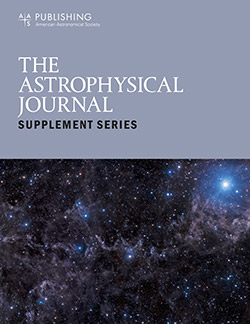局部宇宙中裸活动星系核的观测(z <0.2)。一、论“软过剩”的起源
IF 8.5
1区 物理与天体物理
Q1 ASTRONOMY & ASTROPHYSICS
引用次数: 0
摘要
摘要:我们分析了21个“裸”Seyfert 1活动星系核的样本,Seyfert 1星系是Seyfert 1星系的一个亚类,在局部宇宙(z <0.2)利用XMM-Newton和Swift/XRT观测。计算了主连续体的光度,3-10 keV能量范围内的x射线发射,以及软过剩-出现在3-10 keV x射线能谱幂律拟合的低能量外推之上的多余发射。我们的光谱分析表明,软过剩的长期本征光度与初级连续体紧密相关(lpc∝lse 1.1±0.04)。我们还发现每个光源的光度是相关的。这一结果表明,初级连续统和软过剩排放对吸积速率的依赖性相似。本文章由计算机程序翻译,如有差异,请以英文原文为准。
Survey of Bare Active Galactic Nuclei in the Local Universe (z < 0.2). I. On the Origin of Soft Excess
Abstract We analyze a sample of 21 “bare” Seyfert 1 active galactic nuclei, a subclass of Seyfert 1 galaxies, with intrinsic absorption N H ∼ 10 20 cm −2 , in the local Universe ( z < 0.2) using XMM-Newton and Swift/XRT observations. The luminosities of the primary continuum, the X-ray emission in the 3–10 keV energy range, and the soft excess—the excess emission that appears above the low-energy extrapolation of the power-law fit of 3–10 keV X-ray spectra—are calculated. Our spectral analysis reveals that the long-term intrinsic luminosities of the soft excess and the primary continuum are tightly correlated ( L PC ∝ L SE 1.1 ± 0.04 ) . We also found that the luminosities are correlated for each source. This result suggests that both the primary continuum and soft excess emissions exhibit a dependency on the accretion rate in a similar way.
求助全文
通过发布文献求助,成功后即可免费获取论文全文。
去求助
来源期刊

Astrophysical Journal Supplement Series
地学天文-天文与天体物理
CiteScore
14.50
自引率
5.70%
发文量
264
审稿时长
2 months
期刊介绍:
The Astrophysical Journal Supplement (ApJS) serves as an open-access journal that publishes significant articles featuring extensive data or calculations in the field of astrophysics. It also facilitates Special Issues, presenting thematically related papers simultaneously in a single volume.
 求助内容:
求助内容: 应助结果提醒方式:
应助结果提醒方式:


